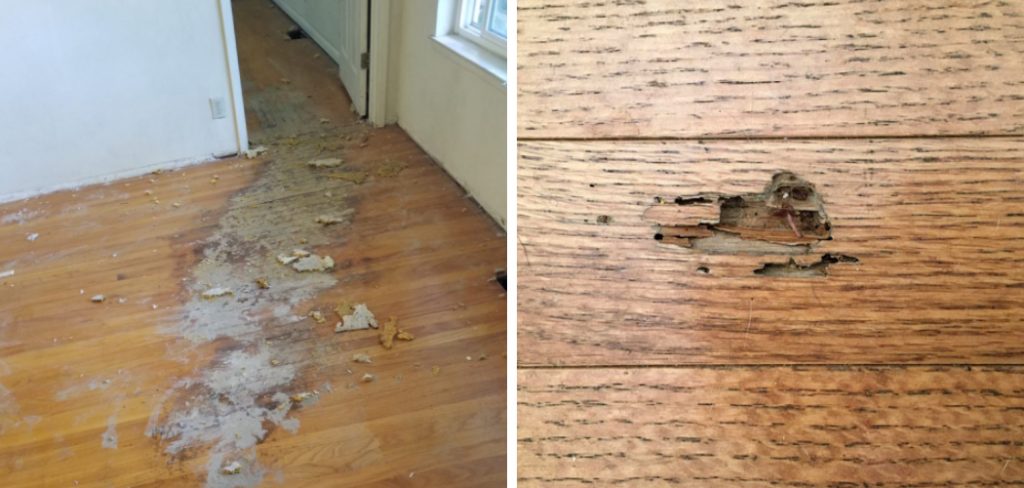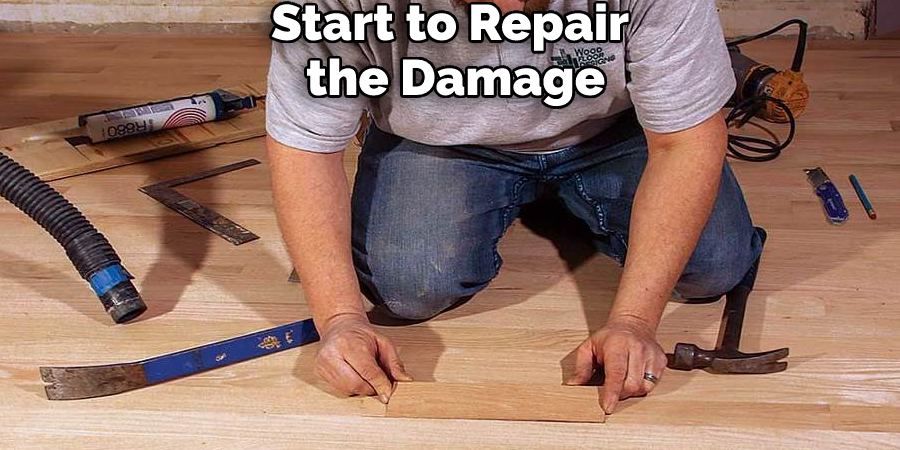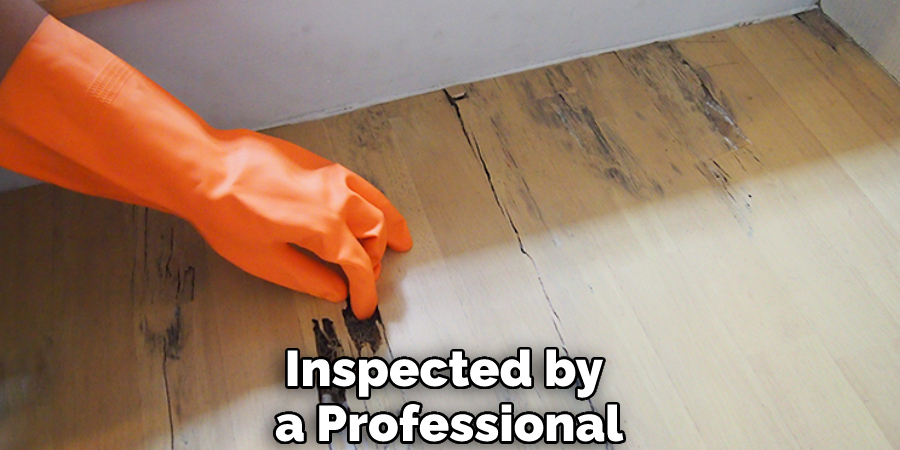Termite damage is usually not covered by homeowners insurance, so it’s important to know how to fix it if you ever find yourself in this situation. The first step is to remove all the damaged wood. This can be difficult and time-consuming, but it’s necessary to prevent the problem from worsening.
Once the damaged wood has been removed, you’ll need to fill in the gaps with new wood. You can either use new floorboards or patch the holes with smaller pieces of wood. Finally, sand and refinish the area to blend it in with the rest of your floor. This blog post will teach you how to fix termite damaged wood floors.
Summary: If you have wood floors that have been damaged by termites, there are a few steps you can take to fix them. First, you’ll need to find out exactly where the damage is. Then, you’ll need to clean it up as best as you can. Finally, you’ll need to apply a sealant to the affected areas.

Step-by-Step Processes for How to Fix Termite Damaged Wood Floors
Step 1: Inspect the Damage
Look for signs of termite damage on your wood floors. These include:
- Buckling or cupping boards
- Gaps between boards
- Cracks in the flooring or baseboards
- Hollow-sounding areas when tapped
Step 2: Find the Source of the Problem
To fix termite-damaged wood floors, you need to find the source of the problem. This could be a termite nest in your floor or damage from moisture. Once you find the source of the problem, you can start to repair the damage.
Step 3: Treat the Affected Area
Once you have removed the damaged wood, treat the affected area with an insecticide or fungicide. This will kill any remaining termites and prevent further damage.
Step 4: Repair the Damage
Once you have found the source of the problem, you can start to repair the damage. If the damage is minor, you may be able to sand it down and refinish the floor. You may need to replace the affected boards if the damage is more severe. If the damage is minor, you may be able to simply sand and refinish the floor. More severe damage may require replacing damaged boards or even the entire floor.

Step 5: Prevent Further Damage
Once you have repaired the damage, you must take steps to prevent further damage. This could include treating your floors for termites or ensuring that there is no moisture in the area. By taking these steps, you can help to ensure that your floors will stay in good condition.
Step 6: Inspect the Rest of Your Home
If you find damage in your wood floors, there is likely damage elsewhere in your home. Inspect your walls, ceilings, and foundation for signs of termite damage.
Step 7: Repair the Damage
Once you have found all of the damage, it is time to repair it. Use a wood filler to fill in any cracks or holes, and then sand the area smoothly. You may need to replace the affected boards if the damage is extensive. Once the damage is repaired, you must treat the area to prevent further termite damage. Several products on the market can be used for this purpose.
Step 8: Stain or Paint the Area
You can stain or paint the repaired area to match the rest of your floors if you want. This is not necessary, but it can help the repair to blend in. Apply a thin layer of stain or paint, and allow it to dry completely before walking on the floor.
Step 9: Prevent Further Damage
You can do a few things to prevent further damage to your wood floors. First, make sure that there is no moisture in your home. This means fixing leaks and ensuring that your gutters are clean and debris-free. Second, keep an eye out for signs of termite damage and call a professional if you see anything suspicious.

Step 10: Monitor the Affected Area
Even after you have repaired the damage, it is important to monitor the affected area for signs of further damage. This is especially important if you live in an area with a high risk of termites. Regularly inspect the area for new damage and termite activity.
Safety Tips for How to Fix Termite Damaged Wood Floors
- Always wear gloves when handling damaged wood.
- Be sure to ventilate the area well to avoid breathing in dust or spores.
- If the damage is extensive, it is best to call a professional for help.
- Inspect any new wood before bringing it into your home to ensure it is not infested.
- Regularly check your home for signs of termites, such as discarded wings or mud tubes.
- Keep firewood and other potential food sources away from your home.
- Store food in sealed containers to avoid attracting pests.
- Repair any cracks or holes in your home’s foundation to prevent termites from entering.
- Use bait traps to control termite populations around your home.
- Regularly have your home inspected by a pest control professional.
What Are Some Common Signs of Termite Damage to Wood Floors?
There are several common signs of termite damage to wood floors. One is the presence of small, pin-sized holes in the wood. Termites make these holes as they tunnel through the wood, and they can be a sign that there is significant damage present. Another common sign of termite damage is buckling or warping in the wood. This can happen as termites eat away at the support beams of a house, causing the floors to become uneven. In some cases, the damage can be so severe that the floor may collapse entirely.
If you suspect that your home has termite damage, it is important to have it inspected by a professional as soon as possible. Termite damage can be very costly to repair, and the sooner it is caught, the better.

Is It Necessary to Call a professional?
If you have found that termites have damaged your wood floors, it is important to take action as soon as possible. The longer you wait, the more damage they will cause. You may wonder if it is necessary to call a professional to fix the problem. While you can try to do it yourself, there are several reasons why it is better to leave it to the experts,
- The first reason is that a professional can properly assess the damage. They will be able to tell you how extensive the damage is and what needs to be done to repair it. This is important because you don’t want to make the problem worse by trying to fix it yourself.
- The second reason is that a professional will have the proper equipment to fix the damage. They will access the right tools and products to complete the job. This is important because you don’t want to end up causing more damage by using the wrong tools or products.
- The third reason is that a professional can fix the damage quickly. They have the experience and knowledge to do the job quickly and efficiently. This is important because you don’t want the problem to drag on and cause more damage.
The fourth reason is that a professional will be able to warranty their work.
How Can I Prevent Further Damage From Termites to My Wood Floors?
You can prevent further damage from termites to your wood floors in several ways. One way is to ensure that there is no food source for the termites. This means keeping your floors clean and free of debris. You should also vacuum regularly and mop up any spills immediately. Another way to prevent termite damage is to treat your wood floors with a termite-resistant finish. This will create a barrier that the termites cannot penetrate.
Finally, you can also try to remove any potential nesting sites for the termites, such as piles of wood or leaves, from your home. Taking these preventive measures can help ensure that your wood floors are safe from further damage.
How to Protect Your Wood Floor from Termites in the Future?
To protect your wood floor from termites in the future, you should make sure to keep your home clean and free of debris. You should also vacuum regularly and mop up any spills immediately. Another way to prevent termite damage is to treat your wood floors with a termite-resistant finish. This will create a barrier that the termites cannot penetrate.
Finally, you should have your home inspected for termites regularly to ensure that they are not causing any damage.

Conclusion
You’re probably wondering to fix termite-damaged wood floors. While the damage they cause can be severe, there are a few things you can do to repair the damage and prevent further damage from occurring.
Flooring is an important part of any home and needs to be well-maintained to last. Termite damage can cause big problems for wood floors, but there are steps that you can take to repair the damage and make your floors look new again. With a little time and effort, you can have beautiful, long-lasting floors that will add value to your home. By following these steps, you will know how to fix termite damaged wood floors and prevent further damage from occurring.
